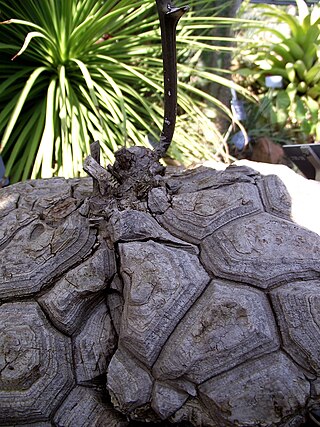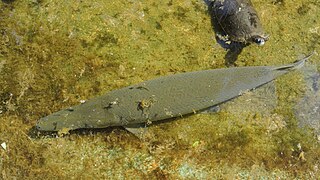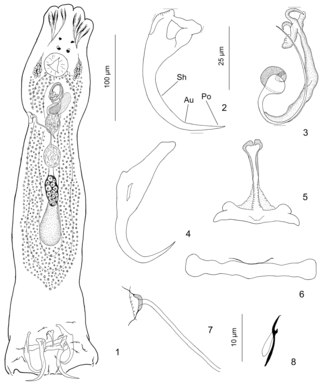Related Research Articles

Magnolia is a large genus of about 210 to 340 flowering plant species in the subfamily Magnolioideae of the family Magnoliaceae. It is named after the French botanist Pierre Magnol.

Tilefishes are mostly small perciform marine fish comprising the family Malacanthidae. They are usually found in sandy areas, especially near coral reefs.

Dioscorea mexicana, Mexican yam or cabeza de negro is a species of yam in the genus Dioscorea.
Gastón Guzmán Huerta, a Mexican mycologist and anthropologist, was an authority on the genus Psilocybe.
The South American land mammal ages (SALMA) establish a geologic timescale for prehistoric South American fauna beginning 64.5 Ma during the Paleocene and continuing through to the Late Pleistocene. These periods are referred to as ages, stages, or intervals and were established using geographic place names where fossil materials where obtained.
Panamanian literature comprises the whole of literary works written in Panama. The first literature relating to Panama can be dated to 1535, with a modern literary movement appearing from the mid-19th century onwards

The Cuban gar, also known as the manjuarí, is a fish in the family Lepisosteidae. It is a tropical, freshwater species, although it also inhabits brackish water. It is found in rivers and lakes of western Cuba and the Isla de la Juventud. The flesh of the fish is edible, but the eggs are poisonous for humans.

Eugerres is a genus of fish in the family Gerreidae, the mojarras. The genus was erected by David Starr Jordan and Barton Warren Evermann in 1927. They are native to the Atlantic and Pacific coasts of the Americas, occurring mainly in salt and brackish waters, but may enter fresh water. The genus also includes one strict fresh water species, E. mexicanus, native to southern Mexico and Guatemala

Aristocleidus is a genus of monogeneans erected by Justus F. Mueller in 1936. The genus has been revised by Delane C. Kritsky and Edgar F. Mendoza–Franco in 2008. The amended generic diagnosis is: species with gonads overlapping, ventral anchors with deeply incised base forming deep and superficial roots, a coiled tube of the male copulatory organ in a clockwise orientation, and haptoral hooks with upright acute thumb, slender shank comprising one subunit and FH loop.
José Luis Castro Aguirre was a Mexican ichthyologist. He was a founding member of the Mexican Ichthyological Society and a member of the National System of Investigators who produced around 150 publications, focusing chiefly on the taxonomy, ecology, and biogeography of the fishes of Mexico. His 1978 book Catálogo sistemático de los peces marinos que penetran en aguas continentales de México, con aspectos zoogeográficos y ecológicos was the first catalog of estuarine fishes of Mexico. Born in Mexico City, he attended the National School of Biological Sciences at the National Polytechnic Institute (ENCB-IPN) earning a master's degree in 1974 and a PhD in 1986. He worked at the National Fisheries Institute and the Food and Agriculture Organization in the 1960s, and later was professor and researcher at the ENCB-IPN, Universidad Autónoma Metropolitana, the Interdisciplinary Center of Marine Science and Northeast Center of Biological Research. He described around a dozen fish species, including several species of shark. A book of research papers in his honor was produced in 2012, and he was posthumously commemorated in the names of the fish species Hypoplectrus castroaguirrei and Eugerres castroaguirrei.

Eugerres plumieri, the striped mojarra, is a demersal fish found in the western Atlantic, from North Carolina south along the U.S. coast, in the Gulf of Mexico, in the Caribbean from Cuba to Puerto Rico, and along the Central and South American coast from Mexico to Colombia. It inhabits shallow coastal waters with low salinity in mangrove-lined creeks and lagoons. It feeds on aquatic insects, crustaceans, micro-bivalves and detritus. This species has high fecundity, producing 85,345 to 953,870 eggs, and reaches a length of 40 cm. It is abundant in Mexico and Colombia, where it is one of the most important fishing resources, both as food and fishing bait.

Ancyrocephalidae is a family of monogenean flatworms. The family is considered as a "temporary name" in WorMS but includes a large number of genera and species.
The Ituzaingó Formation, in older literature also described as Entre Ríos or Entrerriana Formation, is an extensive geological formation of Late Miocene age in the Paraná Basin of the Corrientes, Santa Fe and Entre Ríos Provinces in Mesopotamia, northeastern Argentina. The formation comprises mudstones, cross-bedded sandstones and conglomerates deposited in a fluvio-deltaic environment and is renowned for the preservation of a rich fossil assemblage, including many mammals, birds, reptiles, fish, bivalves, foraminifera, ichnofossils and flora.

Microcotyle archosargi is a species of monogenean, parasitic on the gills of a marine fish. It belongs to the family Microcotylidae. It was first described by MacCallum in 1913 based on ten specimens. Hargis (1956) pointed out that the description and figures given by MacCallum were poor in details.
Microcotyle cepolae is a species of monogenean, parasitic on the gills of a marine fish. It belongs to the family Microcotylidae.

Neodiplectanum is a genus of monopisthocotylean monogeneans, belonging to the family Diplectanidae. According to Mizelle & Blatz (1941), the genus Neodiplectanum "differs from DiplectanumDiesing, 1858, its closest relative, by the presence of two, instead of three, cuticular bars on the haptor". Oliver (1987) thought that the two genera were synonyms, but Neodiplectanum was resurrected later.
Microcotyle tampicensis is a species of monogenean, parasitic on the gills of a marine fish. It belongs to the family Microcotylidae.
Microcotyle danielcarrioni is a species of monogenean, parasitic on the gills of a marine fish. It belongs to the family Microcotylidae.
Microcotyle moyanoi is a species of monogenean, parasitic on the gills of a marine fish. It belongs to the family Microcotylidae.

The Agrio Formation is an Early Cretaceous geologic formation that is up to 1,500 metres (4,900 ft) thick and is located in the southern Mendoza Province and northern-central Neuquén Province, in the Neuquén Basin of northwestern Patagonia, Argentina. This formation is the youngest one of the Mendoza Group, overlying the Mulichinco and Bajada Colorada Formations and overlain by the Huitrín and La Amarga Formations. It is dated to the Late Valanginian to Early Hauterivian, Late Valanginian to Early Barremian, or Hauterivian to earliest Aptian.
References
- 1 2 3 Mendoza Franco, E.F.; Roche, D.G.; Torchin, M.E. (2008). New species of Diplectanum (Monogenoidea: Diplectanidae), and proposal of a new genus of the Dactylogyridae from the gills of gerreid fishes (Teleostei) from Mexico and Panama. Folia Parasitologica. 55: 171-179.
- 1 2 WoRMS (2018). Octouncuhaptor Mendoza-Franco, Roche & Torchin, 2008. Accessed at: http://www.marinespecies.org/aphia.php?p=taxdetails&id=717459 on 2018-12-21
- ↑ González-Solís D. & Sánchez-Ceballos L. D. 2012. — Metazoarios parásitos de la chihua, Eugerres plumieri (Perciformes, Gerreidae) en la Bahía de Chetumal y lagunas adyacentes, Quintana Roo, México, in Del Moral-Flores L. F., Martínez-Pérez J. A., Franco-López J., Ramírez-Villalobos A. J. & Tellomusi J. L. (eds), Investigación Ictiológica en México, Temas Selectos en honor del Dr José Luis Castro Aguirre. Universidad Nacional Autónoma de México, Facultad de Estudios Superiores Iztacala y Sociedad Ictiológica Mexicana, Mexico City: 75-87.
- ↑ Mendoza-Garfias, Berenit; García-Prieto, Luis; León, Gerardo Pérez-Ponce De (2017). "Checklist of the monogenea (Platyhelminthes) parasitic in Mexican aquatic vertebrates". Zoosystema. 39 (4): 501–598. doi:10.5252/z2017n4a5. ISSN 1280-9551. S2CID 89974549.